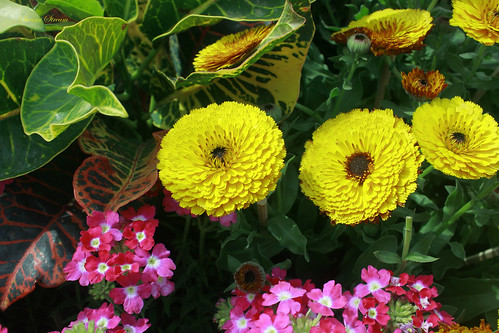Shot these beautiful flowers at the Garden of Five senses in New Delhi. View On Black
Calendula (pronounced /kəˈlɛndjuːlə/ Ca-lén-du-la),[1] pot marigold, is a genus of about 12-20 species of annual or perennial herbaceous plants in the daisy family Asteraceae, native to the area from Macaronesia east through the Mediterranean region to Iran. Calendula should not be confused with other plants that are also known as marigolds, such as plants of the genus Tagetes, corn marigolds or marsh marigolds.
The name Calendula stems from the Latin kalendae, meaning first day of the month, presumably because pot marigolds are in bloom at the start of most months of the year. The common name marigold probably refers to the Virgin Mary, or its old Saxon name 'ymbglidegold', which means 'it turns with the sun'. Marigolds typically bloom quickly (in under two months) in bright yellows, reds, and oranges throughout the summer and well into the fall.
Marigolds are considered by many gardening experts as one of the most versatile flowers to grow in a garden, especially since it is easy to grow. Seeds sown in the spring, in most soils, will germinate freely in sunny or half-sunny locations. They do best, however, if planted in sunny locations with rich, well-drained soil. The leaves are spirally arranged, 5-18 cm long, simple, and slightly hairy. The flower heads range from pastel yellow to deep orange, and are 3-7 cm across, with both ray florets and disc florets. They have a spicy aroma and are produced from spring to autumn in temperate climates. It is recommended to deadhead (removal of dying flower heads) the plants regularly to maintain even blossom production.
Marigolds are used as food plants by the larvae of some Lepidoptera species including Cabbage Moth, The Gothic, Large Yellow Underwing and Setaceous Hebrew Character.
Marigold petals are considered edible. They are often used to add color to salads, and marigold extract is commonly added to chicken feed to produce darker egg yolks. Their aroma, however, is not sweet, and resembles the smell of hops in beer. The oil from its seed contains calendic acid.
More on : en.wikipedia.org/wiki/Calendula
Uploaded by Swami Stream on 16 Jun 09, 6.44AM IST.
Lighthouse in Pondycherry
11 years ago


0 comments:
Post a Comment